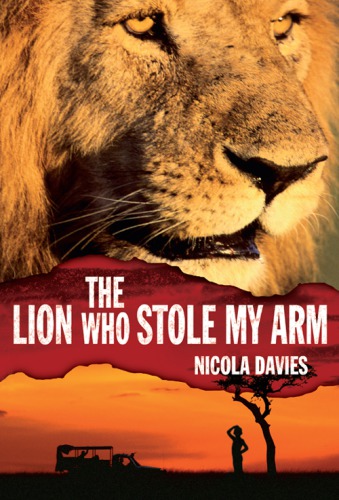
The Lion Who Stole My Arm
Heroes of the Wild
فرمت کتاب
ebook
تاریخ انتشار
2014
Lexile Score
890
Reading Level
4-5
ATOS
5.4
Interest Level
4-8(MG)
نویسنده
Annabel Wrightناشر
Candlewick Pressشابک
9780763670221
کتاب های مرتبط
- اطلاعات
- نقد و بررسی
- دیدگاه کاربران
نقد و بررسی

December 9, 2013
Davies brings her typical sharp insights into animal behavior and ecological conservation to the story of a boy named Pedru, who lives in a small African village. One evening, Pedru is attacked by a lion. He fends it off, but at a cost: “Pedru hit it again, and for a moment it looked right at him, its golden eyes hot like the sun. Then it snarled and ran away, and Pedru saw that it had taken his arm.” Pedru awakens in the hospital—Wright’s watercolor spot illustration shows the boy’s upper arm wrapped in bandages, with nothing remaining below his elbow. During the book, Pedru wrestles with his newfound difficulty writing and his feelings toward the lion, which range from fear and anger to an eventual understanding. While Pedru’s anxieties and frustrations are slow to recede, Davies emphasizes the positive developments that arise from his tragedy, including his discovery of a drawing talent and introduction to a group of scientists studying the lions. An epilogue underpins the story’s positivity, and an afterword details the dire threats facing lions in the wild. Ages 7–10.

WisAwsome - Awsome

March 1, 2014
Gr 2-4-A hungry lion attacks young Pedru, leaving him with just a stump for an arm. In his village, lions are a threat in several ways, but, luckily, he survives, angry and wanting revenge on the lion. Life is drastically changed for him, but he learns to manage by giving up soccer and practicing drawing and using his spear. Despite the author's intent of creating a story to help readers understand the plight of lions in Eastern and Southern Africa, the execution is somewhat inept. There's a lack of clarity as to where the story takes place (clues lead to Mozambique as most likely), what tribal people are being depicted, and when the story takes place. Apparently, the village has rarely been visited by a car, though they know of Land Rovers. In the epilogue, readers learn what has happened to Pedru as an adult and the changes to the village as a result of learning to coexist with lions, implying that most of the book took place during an earlier time period. Much of the factual matter in the back refers to Kenya, and often the author talks in generalities about Africa rather than a specific country. Various animals, birds, and trees are mentioned with footnote descriptions, but when Pedru climbs a tree, there is no mention of what species it is. For a more grounded story at this level, try Alexander McCall Smith's Akimbo and the Lions (Bloomsbury, 2005). On the plus side, this is a short chapter book with black-and-white illustrations and plenty of action that will appeal to unfussy readers who are being introduced to longer fiction.-Carol A. Edwards, Denver Public Library, CO
Copyright 2014 School Library Journal, LLC Used with permission.

December 15, 2013
The terrifying title should attract readers with strong stomachs. Pedru, son of the best local hunter, lives in a village in East Africa. His senses are attuned to the local animals, but one night, while checking his snares at dusk, a lion attacks him. Pedru courageously fights, but he loses his right arm. His life is entirely changed by this event, as the boy meets scientists who are studying lions. He and his father become involved in this project, and his father is later hired when a tourist lodge that allows the lions to be seen but not hunted is built nearby. Pedru goes to college and becomes a scientist himself. The pen-and-wash illustrations provide details on the people, animals and village life in this part of Africa. An afterword gives information about lion-conservation projects and how they protect people while allowing the large cats to live. The author points out that the public should support such projects, but the tourist industry must also provide funds for local people to get the safety fencing, lights and correctly constructed houses. Although the building of the tourist lodge (by an important soccer player related to one of the conservation-project staff members) seems a little far-fetched, this brief tale bridges the gap between the few picture books and longer novels set in this region. Though on the purposive side, the tale both provides adventure and fills a cultural niche for chapter-book readers (Fiction. 8-10)
COPYRIGHT(2013) Kirkus Reviews, ALL RIGHTS RESERVED.

February 1, 2014
Grades 3-5 Lions are a dangerous threat to the people of Pedru's village. Coming home from a fishing trip, Pedru is attacked by a lion, and he loses an arm. As he gains strength in his subordinate hand, Pedru's desire for revenge becomes stronger. Then when a villager is killed by a lion, Pedru accompanies his father to hunt him down. They mistakenly kill a lion wearing a collar, which leads Pedru to the local conservation research unit, where he finds himself at a crossroads he never imagined. Written in plain, simple language, zoologist Davies' slim book carefully teaches without preaching, as Pedru learns to look at lions in a different way and to contemplate peaceful, workable solutions to perilous problems. It also conveys the message that strength comes from within. Wright's black-and-white illustrations evocatively convey Pedru's story. A brief discussion titled Living with Lions follows the story, highlighting the challenges of everyday life, conservation methods to combat extinction, and the Niassa Carnivore Project of Mozambique.(Reprinted with permission of Booklist, copyright 2014, American Library Association.)

























دیدگاه کاربران